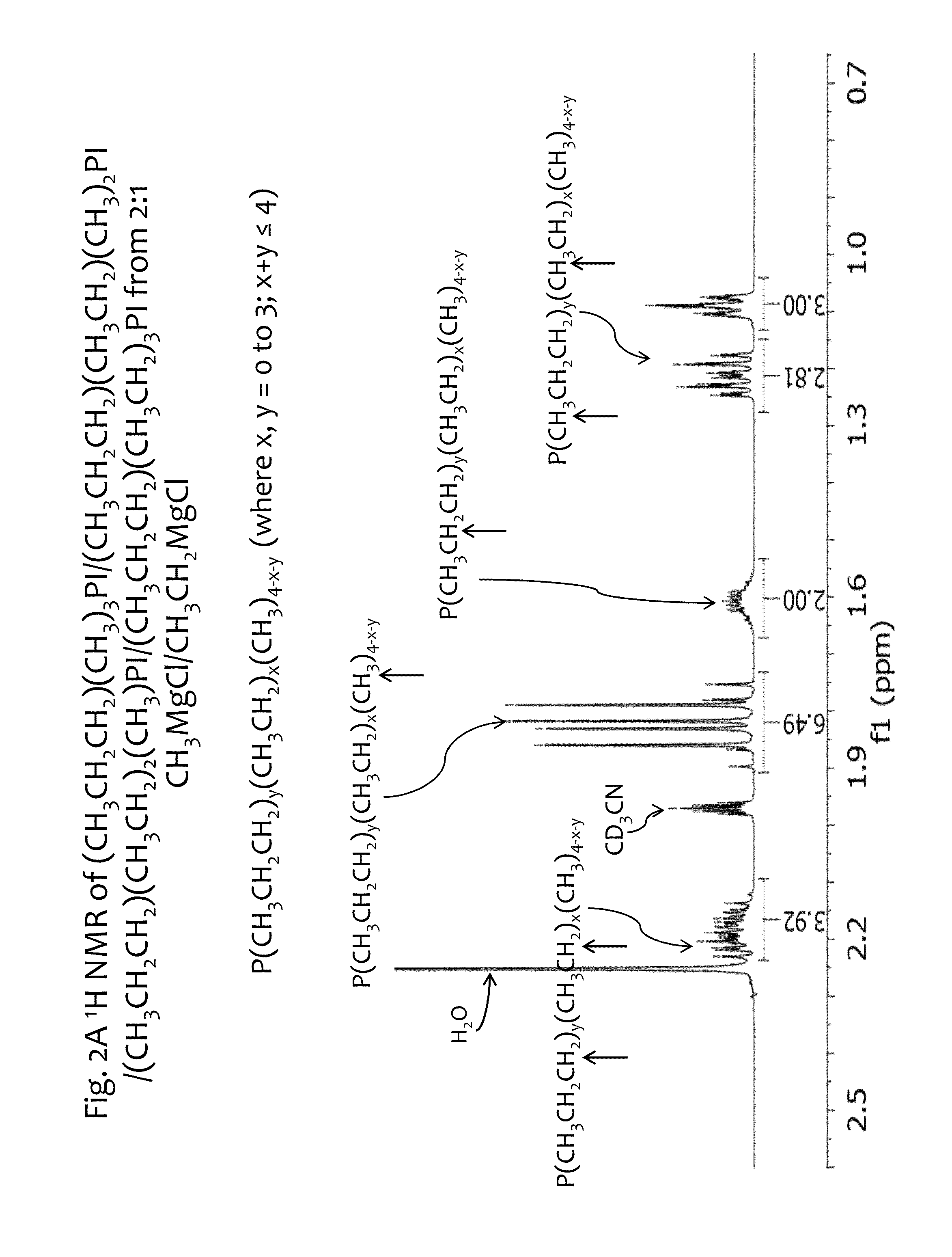Low Symmetry Molecules And Phosphonium Salts, Methods Of Making And Devices Formed There From
- Summary
- Abstract
- Description
- Claims
- Application Information
AI Technical Summary
Benefits of technology
Problems solved by technology
Method used
Image
Examples
example a
[0147]For fa=fb=½, that is a Grignard mixture Ra:Rb=1:1 mole ratio, the following fractions are obtained in the intermediate product mix:
Fraction (Ra)3P=(½)3=⅛
Fraction (Ra)2(Rb)P=3*((½)2*½)=⅜
Fraction (Ra)(Rb)2P=3*(½*(½)2)=⅜
Fraction (Rb)3P=(½)3=⅛
Thus, the mole ratio of (Ra)3P:(Ra)2(Rb)P:(Ra)(Rb)2P:(Rb)3P=1:3:3:1. When normalized to 1 mole product, the composition is comprised of 0.125, 0.375, 0.375, 0.125 moles of (Ra)3P, (Ra)2(Rb)P, (Ra)(Rb)2P, (Rb)3P respectively.
example b
[0148]In another example, For fa= 9 / 10 and fb= 1 / 10, that is a Grignard mixture Ra:Rb=9:1 mole ratio, the following fractions are obtained in the intermediate product mix:
Fraction (Ra)3P=( 9 / 10)3= 729 / 1000
Fraction (Ra)2(Rb)P=3*(( 9 / 10)2* 1 / 10)= 243 / 1000
Fraction (Ra)(Rb)2P=3*( 9 / 10*( 1 / 10)2)= 27 / 1000
Fraction (Rb)3P=( 1 / 10)3= 1 / 1000
Thus, the mole ratio of (Ra)3P:(Ra)2(Rb)P:(Ra)(Rb)2P:(Rb)3P=729:243:27:1. When normalized to 1 mole product, the composition is comprised of 0.729, 0.243, 0.027, 0.001 moles of (Ra)3P, (Ra)2(Rb)P, (Ra(Rb)2P, (Rb)3P respectively.
example c
[0149]In another example For fa=⅔ and fb=⅓, that is a Grignard mixture Ra:Rb=2:1 mole ratio. With Ra=CH3MgX and Rb=CH3CH2MgX, the following fractions are obtained in the intermediate product mix:
Fraction Me3P=(⅔)3= 8 / 27
Fraction EtMe2P=3*((⅔)2*⅓)= 12 / 27
Fraction Et2MeP=3*(⅔*(⅓)2)= 6 / 27
Fraction Et3P=(⅓)3= 1 / 27
Thus, the mole ratio of Me3P:EtMe2P:Et2MeP:Et3P is 8:12:6:1. When normalized to 1 mole product, the composition is comprised of 0.296, 0.444, 0.222, 0.037 moles of Me3P:EtMe2P:Et2MeP:Et3P respectively.
[0150]In some embodiments, the mixture of reagents is comprised of more than two Grignard reagents. For a mixture of three Grignard, Ra, Rb and Rc at mole fractions fa, fb and fc (where fa+fb+fc=1) reacted with PR′3 the distribution of compounds in the intermediate product mix shown in Table 14 is obtained:
TABLE 14CompoundMole Fraction(Ra)3P(fa)3(Rb)3P(fb)3(Rc)3P(fc)3(Ra)2(Rb)P3 * (fa2 * fb)(Ra)(Rb)2P3 * (fa * fb2)(Ra)2(Rc)P3 * (fa2 * fc)(Ra)(Rc)2P3 * (fa * fc2)(Rb)2(Rc)P3 * (fb2 * f...
PUM
 Login to View More
Login to View More Abstract
Description
Claims
Application Information
 Login to View More
Login to View More - R&D
- Intellectual Property
- Life Sciences
- Materials
- Tech Scout
- Unparalleled Data Quality
- Higher Quality Content
- 60% Fewer Hallucinations
Browse by: Latest US Patents, China's latest patents, Technical Efficacy Thesaurus, Application Domain, Technology Topic, Popular Technical Reports.
© 2025 PatSnap. All rights reserved.Legal|Privacy policy|Modern Slavery Act Transparency Statement|Sitemap|About US| Contact US: help@patsnap.com



